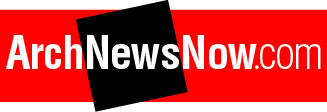
Home About Us Contact Us Subscribe

Home About Us Contact Us Subscribe
|
|
|
|
Sleek Signs: Acela Station Signage by Calori & Vanden-Eynden / Design Consultants
Signage design meets industrial design at stations serving Amtrak's futuristic bullet trains. by ArchNewsNow July 22, 2002 Amtrak has paid attention to all the details, including signage, in developing the sophisticated new Acela Express trains and service. As the futuristic bullet trains glide into their Northeast Corridor stations, the resemblance between the streamlined locomotives and the sleek new signs punctuating the platform canopies is plain to see - and easy to understand - even to the average weary commuter.
Since the signage was to be implemented in architecturally diverse stations along the 440-mile route, New York City-based Calori & Vanden-Eynden (C&VE) quickly realized that the distinctive bullet trains themselves were the sole visual constant linking the stations. Accordingly, "The visual relationship between the trains and the signage is a completely intentional brand image statement," says C&VE principal David Vanden-Eynden, who, together with co-principal Chris Calori and their staff, designed the unique Acela signage.
A sensuously curved "airfoil" shape, as the C&VE design team dubbed it, became the stylistic nucleus of the entire Acela signage program, which ranges from large ground-mounted pylons to canopy-mounted and wall-mounted "wing" signs.
The typical sign body is a double-airfoil shape, featuring two back-to-back curved panels, with key units intersected by a curved vertical fin to evoke movement. "In a singular statement of three-dimensional form, the Acela signage embodies the speed and aerodynamics of the new locomotives," Calori says. The sign program's silver and teal colors match those of the new trains, further reinforcing the Acela identity.
"The Acela signage is breaking new ground in the branding arena," Calori continues. "Rather than being logotype-driven, the program derives its branding strength from its sculptural sign forms. And since the signs fulfill the passenger's need for orientation and schedule information, they link an essential customer service directly to the brand."
The distinctively sleek signage is currently installed at select stations along the Northeast Corridor from Boston to Washington, DC. "Launching the Acela service has been a tremendous effort on the part of all involved," says Vanden-Eynden, "and we commend Amtrak for recognizing the importance of signage in building brand equity and customer loyalty."
The program has garnered an impressive number of awards. The Acela signage received a 2001 Gold IDEA (Industrial Design Excellence Award) (considered by many to be the "Oscar of Design") from the Industrial Designers Society of America (IDSA) and Business Week magazine. The jury commented: “Distinctive but understated sculptural forms... effective branding consistency... aesthetically appropriate in the diverse architectural environments.” It also received an Award of Excellence in the 2001 American Institute of Graphic Arts (AIGA) 365 Annual Design Competitions, and an Award of Merit in the Society for Environmental Graphic Design (SEGD) Annual Awards Program. It was cited in The New York Times, and received an Award of Excellence in the American Corporate Identity 17th Annual Awards Program. The Acela signage was exhibted at the AIGA National Design Gallery earlier this year, and will be featured in two upcoming design annuals. Also, Amtrak itself received the SEGD's 2001 Insight Award for its outstanding design advocacy.
As with a fully loaded sports car, the trim, streamlined shapes of the Acela sign program belie its technical complexity. In fact, in C&VE's IDEA acceptance speech, Mr. Vanden-Eynden thanked Business Week and the IDSA for recognizing that "there's a lot of industrial design in signage design."
Building on the success of the regional Acela signage, C&VE's work with Amtrak has expanded to include development of a new nationwide Amtrak exterior station identification and directional signage program.
Calori
& Vanden-Eynden Design Team: David Vanden-Eynden, Chris Calori, Jordan
Marcus, Denise Funaro. Architect:
Wallace Roberts & Todd Lighting
Design: Fisher Marantz Stone Sign
Fabricator: Andco Industries For
Acela: Amtrak Station Programs and Planning Department Photography:
Elliott Kaufman Photography; Stan Feldman (Acela train) Calori &
Vanden-Eynden (C&VE)
is a leading design consulting firm specializing in signage and brand identity
design. The award-winning, internationally-recognized firm's projects include
the first citywide wayfinding and signage program for Washington, DC; the
Connect 12 signage and branding program for Central Hong Kong's pedestrian
bridge network; and the signage and identity programs for the One Raffles Link
office building and the Citylink Mall in Singapore. C&VE's clients include
the Hongkong Land Company, ABC Broadcasting, The Rockefeller Group, and the
architectural firms Kohn Pedersen Fox Associates and Michael Graves &
Associates. Editor's note: C&VE is also responsible for ArchNewsNow's site design and logo, for which we are most grateful! |
(click on pictures to enlarge) 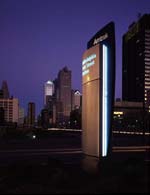 (Elliott Kaufman Photography) The sleek Acela signage program includes exterior station identification pylons, internally illuminated at night, as seen here in Philadelphia.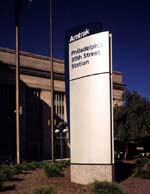 (Elliott Kaufman Photography) Exterior station identification pylon by day, Philadelphia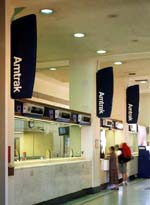 (Elliott Kaufman Photography) Ticket counter brand identification signs and window service information signs with LED displays, Baltimore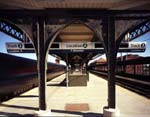 (Elliott Kaufman Photography) Track identification "wing" with LED train information display, Wilmington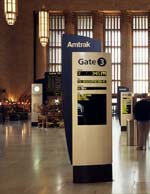 (Elliott Kaufman Photography) Gate identification kiosk with LED schedule information display, Philadelphia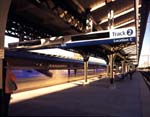 (Elliott Kaufman Photography) Track identification "wing" with LED train information display, Wilmington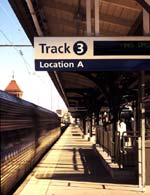 (Elliott Kaufman Photography) Track identification "wing" with LED train information display, Wilmington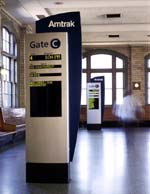 (Elliott Kaufman Photography) Gate identification kiosk with LED schedule information display, Baltimore (Stan Feldman) A streamlined Acela train |
© 2002 ArchNewsNow.com